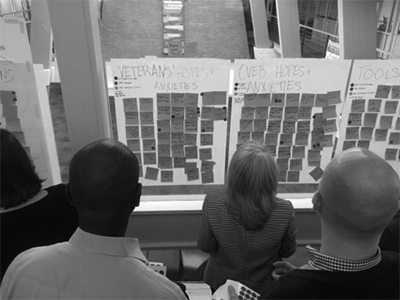On Designed Things
Designers Make Things: Products, Services and Systems
Illustration from the HCD Design Phase Concept Guide showing how different designed things can be created from the same opportunity space, and how designed things from adjacent opportunity spaces can be quite different from one another.
What do designers make, exactly? It’s a question I ran into while writing the Human-Centered Design Design Phase Concept Guide. It was surprising to get stuck here! Why was this even a question? Why was it a difficult knot to unpick? But, as my editor asked me at the time “You have to tell people when they get to the designing part; what is it? What should they expect to make?! Even I’m waiting to find out!”
I tried to untangle it using the traditional divisions of design that have surfaced in the last twenty years or so: product design and service design. But as I considered complex organizations and ecosystems, instead of discovering the boundaries between products, services and systems, they seemed to knit together in complex weaving patterns.

Illustration by Lab team member Tim Vienckowski
As I followed my thinking and project experiences through this logic, as I talked to my colleagues and read articles and histories of design and policy, I discovered these weaving patterns in greater granularity. And on top of that (or perhaps beneath it, depending on how you look at it), there was another design layer: system design. This is because when working in complex organizations or ecosystems, the design of a system is as crucial as the products and services themselves. All three aspects of designed things could be named and conceptually separated from each other, but they cannot practically function without one another because they have dependencies, fill gaps, and create bridges for participants. 1

Illustration by Lab team member Tim Vienckowski
Products give access to services, which then support systems, which are then defined by other products or services, each with their subset of interrelated features. The network effect of them working together creates a unified and elegant experience, while their separation or silo-ing results in stilted or even chaotic system navigation.

Illustration by Lab team member Tim Vienckowski
Thusly, in complex organizations and circumstances, thinking of product, service, and system design separately is artificial. 2 Although there will always be a need for specialities, the overall design work in an organization must be done in concert across these sectors to create the best answer for participants. Embracing inter-dependencies allows us to lighten the load of useless redundancies and increase useful ones, 3 creating long-term efficiencies for product, service, and system management and serving participants better.
- In parsing this issue, I looked back at products like the Welcome to Telehealth Kit and the Telehealth Toolkit, both for the Office of Telehealth [long distance medicine] in the Veterans Health Administration. These projects required the design of products and services in order to support the ongoing Telehealth system.
- This is similar to my concept of Teamwork. Please see the On Teamwork.
- Read more about the concept of useful redundancies in the article [link]On Design and Government[link] or in the Community Veterans Engagement Boards (CVEBs) project.



